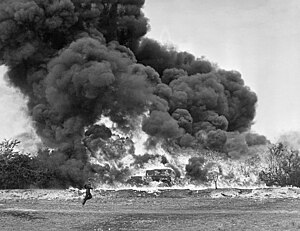Flame fougasse
| Flame fougasse | |
|---|---|

A demonstration of 'Fougasse', somewhere in Britain. A car is surrounded in flames and a huge cloud of smoke. c 1940.
|
|
| Type | Anti-personnel and anti-tank mine |
| Place of origin | United Kingdom |
| Service history | |
| In service | 1940–present |
| Used by | British Army and Home Guard |
| Wars | World War II |
| Production history | |
| Designer | Petroleum Warfare Department and William Howard Livens |
| Designed | 1940-41 |
| No. built | 50,000 in Britain |
| Specifications | |
| Rate of fire | Single shot |
| Effective firing range | 30 yards (27 m) long. |
| Sights | None |
A flame fougasse (sometimes contracted to fougasse and may be spelled foo gas) is a type of mine or improvised explosive device which uses an explosive charge to project burning liquid onto a target. The flame fougasse was developed by the Petroleum Warfare Department in Britain as an anti-tank weapon during the invasion crisis of 1940. During that period, about 50,000 flame fougasse barrels were deployed in some 7,000 batteries, mostly in southern England and a little later at 2,000 sites in Scotland. Although never used in combat in Britain, the design saw action later in Greece.
Later in World War II, Germany and Russia developed flame throwing mines that worked on a somewhat different principle. After World War II, flame fougasses similar to the original British design have been used in several conflicts including the Korean and Vietnam Wars where it was improvised from easily available parts. The flame fougasse remains in army field manuals as a battlefield expedient to the present day.
Following the Dunkirk evacuation in 1940, Britain faced a shortage of weapons. In particular, there was a severe scarcity of anti-tank weapons, many of which had to be left behind in France. One of the few resources not in short supply was petroleum oil since supplies intended for Europe were filling British storage facilities.
Maurice Hankey, then a cabinet minister without portfolio, joined the Ministerial Committee on Civil Defence (CDC) chaired by Sir John Anderson, the Secretary of State for the Home Office and Home Security. Among many ideas, Hankey "brought out of his stable a hobby horse which he had ridden very hard in the 1914–18 war – namely the use of burning oil for defensive purposes." Hankey believed that oil should not just be denied to an invader, but used to impede him. Towards the end of June, Hankey brought his scheme up at a meeting of the Oil Control Board and produced for Commander-in-Chief Home Forces Edmund Ironside extracts of his paper on experiments with oil in the First World War. On 5 June, Churchill authorised Geoffrey Lloyd, the Secretary for Petroleum to press ahead with experiments with Hankey taking the matter under his general supervision. To this end, the Petroleum Warfare Department (PWD) was created and it was made responsible for developing weapons and tactics. Sir Donald Banks was put in charge of the department.
...
Wikipedia
